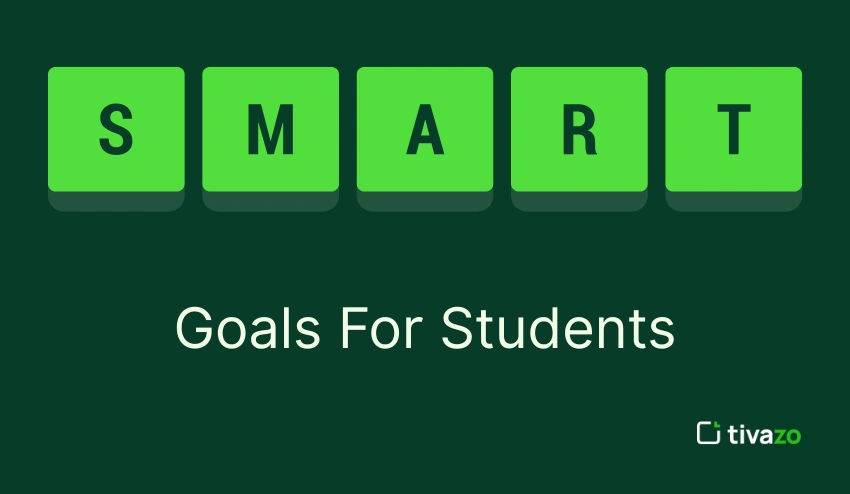How much better to complete the semester with no final cramming or stress, feeling confident, organized, and proud of what you have accomplished. This can be a far-off dream to most students, but with the right plan, it can be very achievable.
The trick is to make SMART goals for students, a systematic approach to transforming the ambitious and unspecific vision into a specific and attainable outcome. Between grades and time management, academic goal setting gives students a sense of direction and encouragement to continue tracking their progress and achieve their full potential.
Students are able to develop a roadmap towards success by setting out specific, measurable, achievable, relevant, and time-bound goals. Not only do SMART goals increase focus and productivity, but they also increase self-discipline and decrease academic anxiety. You may not be looking to achieve academic excellence, be in an extracurricular, or gain the skills needed, but whether you are, you need to know how to set SMART goals for students, and then, and only then, can you achieve something meaningful.
What Are SMART Goals?
SMART goals for students are clear, structured objectives that are Specific, Measurable, Achievable, Relevant, and Time-bound, designed to guide academic performance and personal development effectively.
With SMART goals, unrealistic goals such as improving my grades are transformed into goals with specific steps and targets. Students are more efficient in goal setting and stress-free in academic activities because this method helps them to maintain focus, keep track of progress, manage time effectively, and remain motivated.
Why Should Students Set SMART Goals?
Students should set SMART goals because they provide clear direction, measurable progress, and motivation, helping students achieve academic success efficiently.
When a student uses SMART goals, priorities are more concentrated, tasks become manageable, and easier to follow with time improvement. This systematic method eliminates stress, builds confidence, and promotes sustained effort, so academic goal setting is an effective method of achieving short-term and long-term success.
How to Create Effective SMART Goals
Creating SMART goals for students is a structured way to turn aspirations into actionable steps. By following a clear process, students can set goals that are realistic, measurable, and motivating.

Steps to Create Effective SMART Goals:
- Be Specific: Clearly define what you want to achieve.
- Make It Measurable: Establish criteria to track progress.
- Ensure It’s Achievable: Set realistic goals you can accomplish.
- Keep It Relevant: Align the goal with your academic and personal priorities.
- Set a Time Frame: Define a clear deadline to stay on track.
- Break It Down: Divide larger goals into smaller, manageable tasks.
- Review and Adjust: Regularly assess progress and make necessary changes.
Following these steps helps students stay focused, organized, and motivated. Consistently applying academic goal-setting strategies ensures meaningful progress and academic success.
7 Effective Smart Goals for Students Examples
Having SMART goals for students assists in transforming the intention into measurable accomplishment. Students can learn how to use the SMART framework in their own academic process by examining real-world examples.
1. Improve Academic Grades
One of the SMART goals for students may be to have better grades in a given subject. An example would be: I will improve my biology grade to a B by doing all assignments on schedule and having weekly study hours. This objective is time-bound, measurable, and specific, and provides the students with an objective to pursue. If students find themselves struggling with assignments or research papers, they can hire DoMyEssay for expert research paper help to stay on track and improve their academic performance.
Reaching such a SMART goal would motivate students to develop regular study patterns. The ability to monitor homework by habitually tracking it, revisiting major concepts, and seeking guidance when needed leads to students forming habitual practices that have a direct effect on academic performance.
Having such a goal also increases confidence and motivation. This will be reinforced when the students notice a corresponding positive change in their grades, and it proves that the setting of academic goals can build physical success.
2. Enhance Time Management
A SMART goal that students can establish to better manage their time includes: I will allocate two hours a day to two concentrated study sessions through the Pomodoro technique over the next month. This is a specific, measurable, and attainable goal within a specified time.
Students can learn to organize their learning and minimize procrastination by dedicating themselves to well-defined study periods. Applying time-management techniques as SMART goals for students can assist them in coordinating their academic tasks with extracurricular activities and other personal roles.
This would eventually lead to discipline and productivity. The effectiveness of SMART goal planning is confirmed when the students adhere to their time-management objectives and become more efficient, less stressed, and highly motivated to achieve better performance.
3. Develop Study Skills
The other SMART goals for students are aimed at developing particular study skills. An example can be given of the following: I will enhance my skills in note-taking; I will provide a brief summary of the content of each chapter at the end of each lecture in my own words in a month. This is a measurable, achievable, and directly related outcome to learning.
This objective is best understood through practice. The active process of summarizing and reviewing material causes the student to be more involved in the learning process, which results in improved comprehension during examinations and assignments.
Also, this SMART goal promotes self-direction in learning and responsibility. Learners develop confidence in their information-processing and retention capacity, which underscores how setting goals at an academic level can help students enhance critical skills, not necessarily in terms of grades.
4. Participate in Extracurricular Activities
SMART goals for students can be applied to include extracurricular activities, including: I will participate in the debate club and come to at least two meetings each month during this semester. This is a specific, objective, and measurable goal, as well as consistent with personal development.
Membership in any type of club or activity develops important skills such as communication skills, teamwork skills, and leadership skills. Academic goal setting that incorporates such goals assists students in acquiring balanced skills that complement classroom learning.
It also enhances confidence and social skills when one is involved regularly. The attainment of this SMART goal allows students to experience observable personal and academic improvement, which once again underlines the significance of balanced improvement.
5. Improve Physical Well-being
An example of SMART goals for students could be: “In the next two months, I will exercise 3 times a week for 30 minutes. This is a precise, quantifiable, and attainable objective over a period of time.
Exercising helps in enhancing vigour, focus, and sharpness. Students with health-related SMART goals have fewer distractions and more concentration time to study.
Also, focusing on physical health decreases stress and enhances balance in general. That proves that SMART goals for students can be applied not only to academic achievements but also help students achieve success in their lives in a holistic way.
6. Boost Attendance and Participation
To make the classroom more active, students can aim at a SMART goal: I will attend all lectures and discuss with the teacher the whole semester. This is a specific, timely, and relevant goal.
Regular attendance and participation enhance knowledge on the topic. The next SMART goal can stimulate active learning and assist students in memorizing the information more efficiently.
In addition, frequent interaction enhances the relationships with the teacher and peers. The attainment of this aim demonstrates how academic goal setting can lead to the development of academic performance and interpersonal development.
7. Enhance Time for Personal Development
Another final SMART goals for students might be: I will read non-academic books 30 minutes a day over the next month. This is a specific and measurable goal, and it enables students to acquire skills outside the classroom.
Participation in personal development fosters critical thinking, creativity, and emotional intelligence. Integrating such objectives into the day-to-day life of a student supplements the process of academic learning and facilitates lifelong learning.
By means of this SMART goal, the significance of balance is strengthened. Through taking time to develop as a person, students will experience how SMART goals for students can enhance student academic and well-being.
These SMART goals for students are practical demonstrations of both academic and personal development. Using the same strategies, students will be able to make specific, quantifiable plans that spur continuous improvement and achievement.
SMART Goals For Students With Anxiety
Anxious students tend to have difficulties with organizing school life and managing it, so organizing SMART goals for students with anxiety can be a form of order and a way of eliminating certain stress. Dividing large tasks into small, manageable ones will allow students to concentrate on one task at a time, monitor progress, and celebrate small successes. In our case, a SMART goal might be: I will read one chapter of my science textbook every day during the course of a week, rather than having a vaguely stated goal: study more. Academic goal setting can be more manageable and more motivating because it is a time-bound, quantifiable, specific, relevant, and measurable approach.

SMART goals also assist students in managing their time better, prioritizing their tasks, and becoming more confident and less overwhelmed. The inclusion of such strategies as regular breaks, goal adjustments, and recognition of minor accomplishments allows students to be consistent and relaxed.
Key Tips for SMART Goals for Students with Anxiety:
- Break large assignments into smaller, manageable tasks
- Set realistic daily or weekly targets
- Use specific and measurable objectives to track progress
- Take regular breaks during study sessions to reduce stress
- Celebrate small achievements to boost confidence
- Prioritize tasks to focus on what’s most important
- Adjust goals as needed based on anxiety levels and workload
SMART Goals For Students With Autism
Students with Autism thrive on organization and expectations, and SMART goals for students with autism are very effective. Students will be able to concentrate on specific goals, have confidence, and monitor progress by setting goals that are specific, measurable, achievable, relevant, and time-bound. The example: “I will do my math homework of 30 minutes a day this week with very little help.”
The proposed goals also assist in building such critical competencies as time management, organization, and self-regulation. Dividing tasks into small steps and rewarding small accomplishments can help maintain consistent progress and reduce stress levels, so academic goal setting can be a valuable method to be used by autistic students.
SMART Goals For Nursing Students
Nursing students have a rigorous curriculum with challenging academic knowledge and practical skills. Nurse students should have SMART goals that can be set to subdivide complex goals into specific, attainable steps. One such SMART goal might be: I will be able to complete all clinical skills checklists during this rotation, by practicing 30 minutes a day over the course of two weeks. This makes the goals specific, measurable, achievable, relevant, and time-bound to keep the students focused and organized.
The use of SMART goals also helps with time management, mastering of skills, and stress reduction. Nursing students can enhance competence and confidence in both the classroom and clinical environments through monitoring of progress and recognizing small milestones, which is why academic goal setting is a critical tool of success in their demanding programs.

Key Tips for SMART Goals for Nursing Students:
- Break down clinical and theoretical tasks into manageable steps
- Set daily or weekly practice goals for skills and knowledge
- Track progress regularly to identify areas needing improvement
- Prioritize critical tasks during high-stress rotations
- Reward small achievements to stay motivated and confident
Short-Term SMART Goals for Students
- Complete daily assignments on time: “I will finish all math homework by 8 PM each day this week.”
- Improve study habits: “I will dedicate 30 minutes each day to reviewing lecture notes for the next five days.”
- Increase class participation: “I will ask at least one question or contribute one comment in every class this week.”
- Organize study materials: “I will organize my notes and textbooks for each subject by the end of the day every Sunday.”
- Practice a specific skill: “I will practice one clinical nursing skill for 20 minutes daily this week.”
- Boost memory retention: “I will use flashcards to review 20 key terms per day for the next five days.”
- Prepare for quizzes: “I will complete one practice quiz per day before the next scheduled test.”
What are the 5 W’s in SMART goals?
1. Who – Identify the people involved
The SMART goals for students should specify who is to meet the goal. This may be the student themselves or teachers, mentors, or peers to guide him/her. Knowledge of who to hold accountable and clarity on support mechanisms required to achieve the goal.
2. What – Define the exact objective
A specific and measurable goal is clearly stated. An example of a SMART goal would be: I will do three math practice quizzes this week. Identifying what makes students pay attention to concrete actions and outcomes.
3. Where – Specify the location or environment
This will assist students in planning and reducing distractions by indicating where the goal will be achieved. A SMART goal would be to have a quiet study place at home or a library time. The location setting makes the environment conducive to concentration and productivity.
4. When – Set a clear timeline
Setting time limits within which a goal must be achieved introduces a time constraint to the goal, and progress is quantifiable. As an example, the student will want to finish a project by Friday. Adding a time frame to SMART goals for students makes them responsible and motivates them to work regularly.
5. Why – Understand the purpose
Students will be more motivated by knowing the purpose of the goal. A SMART goal targeted at students must be tied to academic achievement or skill acquisition, or personal advancement. The purpose gives meaning and strengthens the worth of fulfilling the objective.
Conclusion
This is because one of the best ideas to supercharge the performance of students, maintain organization, and attain self-growth is to set SMART goals. With practice in determining goals, students can transform wishes, thoughts, and dreams into real actions and monitor their advancement. Setting academic goals on a daily basis fosters coping with stress, increased concentration, and self-confidence. Students who use SMART goals understand where to go, acquire skills, improve academic achievement, and juggle a balance between personal and academic commitments, is a definite roadmap to success. Are you prepared to begin defining your SMART expectations of our students and be in charge of your studies now?




